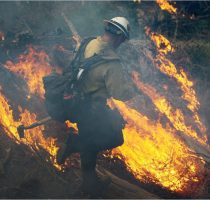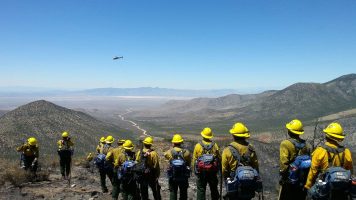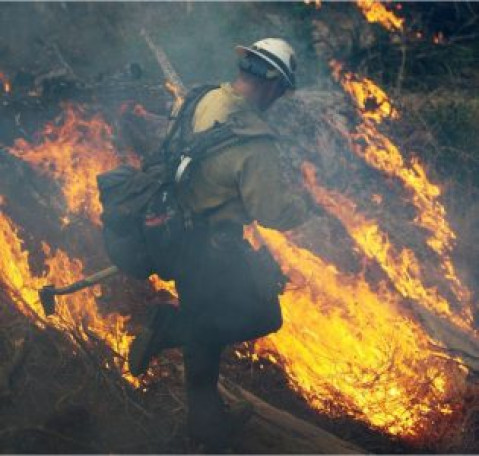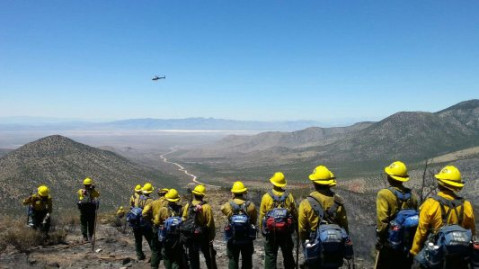Widgetized Section
Go to Admin » Appearance » Widgets » and move Gabfire Widget: Social into that MastheadOverlay zone
Teleological Approaches to Wildfires
The views expressed are those of the author and do not necessarily reflect the views of ASPA as an organization.
By Tracy Rickman, Ygnacio “Nash” Flores, Don Mason and Cliff Hadsell
January 22, 2018
The past years of California’s fire seasons has shown that wildfire season is now a year-long event. There are many reasons for the increase in wildfires and it is the cause of much debate. Arguments range from encroachment into forested areas, climate change and, of course, to fiscal management of public funds. Many of these discussions concentrate on possible precursors of events associated with wildfires. There is also a need to add teleological theory to this national conversation. Wildfires are eventually judged by the end results of the devastation. This includes second order effects such as the recent January 2018 fatalities caused by mudslides in areas recently burned by wildfires in Southern California. Modeling “how” administrators respond to wildland fires can be viewed and measured by many means. One could look at the fire prevention aspect, the increase of urban interface where people have moved deeper and deeper into the forest. One could also review the environmental aspect where logging and other means of “thinning the forest” has changed over the years. If administrators do not think about the forest and its needs, and continue to allow more and more people to build in the forest, there will continue to be an increased loss of life and property from wildfires.
The climate change theory and forest management are also perspectives many seek to find solutions or  at least an explanation of the fire phenomenon which is currently resulting in hundreds of thousands of acres of burned area each year. The damage from California’s recent wildfires forces administrators to ask two fundamental questions: First, is the traditional way of preparing and responding to these major conflagrations antiquated? Second, is there a new model that must be implemented to meet contemporary threats from wildfires?
at least an explanation of the fire phenomenon which is currently resulting in hundreds of thousands of acres of burned area each year. The damage from California’s recent wildfires forces administrators to ask two fundamental questions: First, is the traditional way of preparing and responding to these major conflagrations antiquated? Second, is there a new model that must be implemented to meet contemporary threats from wildfires?
Teleological ethics is an aspect that should be considered when devising plans to reduce or respond to these devastating fires. Viewing wildfires from the end result can change perspectives on how administrators prepare for this unique hazard. There are many facets and considerations when seeking results tied to the reduction of wildfires. A teleological approach to hazard mitigation stresses the correctness of an act is primarily determined by its result. Therefore, the means are justified by the desired end result. This approach has its own shortcomings, as administrators must consider other ethical aspects of answering the “ought” of what administrators need to do to mitigate future wildland fires. Reframing mitigation planning through a teleological lens can shed light on actions that may not draw attention until a hazard is viewed through hindsight. Moral actions frame the question of “ought” on providing reducing the severity of wildfires. What is right and what is wrong is the corner stone of ethics. What is good needs to be defined by administrators willing to view the issue of wildfires from multiple perspectives.
Normative ethics in public administration would define a standard of conduct based upon societal views. However, the collective voice of society can change in the many contemporary issues faced by the nation. With the recent national discussions on a new tax bill, changing of healthcare laws and the Deferred Action for Childhood Arrivals (DACA), leaders must include in the national discussion the ethics of decisionmaking. Teleological ethics would argue that an action in itself being right or wrong, will be judged by the consequences of the actions taken. This is a powerful insight for administrators.
Administrators need to look at the prevention of wildfires from the perspective of being fiscal stewards. Governments at the local, state and federal levels spend millions of dollars on suppression efforts. Considering the prevention aspect would result in less conflagrations and loss due to wildfire. After action studies have shown that often unethical conditions existed before wildfires; however, these conditions were not always easily identified. Decisionmaking is often led by the pressures to get the job done quickly, as well as other social factors that call for immediate measurable outcomes. Yet, many fail to recognize that unethical practices allowed forests to become overgrown in densely populated areas, setting up the elements for a wildfire.
 The Josephson Institute has for many years established a commitment for increased ethical competence and individual responsibility in administration and leadership. Public servants are faced with a large number of rules, governance, past practice and other inherently difficult standards to abide by when administering public programs. Each of these factors can cause ethical dilemmas for the administrator. As leaders, public administrators must acknowledge that if they permit people to build and expand in areas prone to high fire hazard, the nation will continue to see an increase of loss from wildfires. If administrators do not properly thin forests and spend funds on prevention, the current situation will not change. Continuing with antiquated past practices will not mitigate future wildfires. As leaders in charge of public safety, administrators must look outside the box and reframe their ethical perspectives in decision making. It is time to shift the focus of fire prevention. The current focus in on environmental concerns that lack practices to increase forest protection. Future public planning has to consider building with smart fire safety in mind. As an administrator, you must decide if you want to pay now or pay later.
The Josephson Institute has for many years established a commitment for increased ethical competence and individual responsibility in administration and leadership. Public servants are faced with a large number of rules, governance, past practice and other inherently difficult standards to abide by when administering public programs. Each of these factors can cause ethical dilemmas for the administrator. As leaders, public administrators must acknowledge that if they permit people to build and expand in areas prone to high fire hazard, the nation will continue to see an increase of loss from wildfires. If administrators do not properly thin forests and spend funds on prevention, the current situation will not change. Continuing with antiquated past practices will not mitigate future wildfires. As leaders in charge of public safety, administrators must look outside the box and reframe their ethical perspectives in decision making. It is time to shift the focus of fire prevention. The current focus in on environmental concerns that lack practices to increase forest protection. Future public planning has to consider building with smart fire safety in mind. As an administrator, you must decide if you want to pay now or pay later.
Author: Ygnacio “Nash” Flores, EdD, MBA, MPS, MA, is a faculty member in Public Safety Rio Hondo College. Email: [email protected].






 (4 votes, average: 4.25 out of 5)
(4 votes, average: 4.25 out of 5)
Hector Gutierrez
November 7, 2022 at 4:53 pm
Having been part of a wildland crew myself, I too agree that there are a number of reasons for the increase in wildfires we’ve been experiencing these past years. While there has been much debate and methods implemented in attempts of stopping this increase, we have not found much success. Ultimately, a wildfire incident is deemed unsuccessful or successful based on the loss of life and property, even after the fire has been controlled (mudslides and/or landslides). While the acres being burned is also a factor to take into consideration, politicians focus on the other two factors more to maintain their public image due to the continued expansion of the Wildland Urban Interface (WUI) that has occurred over the past couple decades. Even with the implementation of successful ideas and methods, I believe some of the reasons for the increase in wildfires cannot be addressed. As a result, we should factor those reasons out and focus on the reasons we can address.
When it comes to the issue of wildfires many of the solutions being discussed are centered around mitigation, preparedness, response, and recovery. I agree that governments at the local, state, and federal level generally focus on the response aspect of wildfires as they spend millions of dollars annually on suppression efforts. I agree that this aspect is crucial, but I believe that the focus should be shifted towards the prevention aspect as it would result in less conflagrations and loss due to wildfires. I believe that politicians have a major role in the focus being placed on the response aspect as they tend to address issues that are current and tend to forget about the issues once they been addressed. While politicians have a fault for this, I believe it is also the failure of citizens to push politicians to address these issues. Many people are horrified and voice their desires for changes during wildfires, but as soon as the wildfires are contained and controlled, it is almost like the wildfires never existed. As a result, it is not only the fault of the government, but also that too of the citizens who must do their part in voicing their opinion and altering their homes to be protected against wildfires. While I agree that the government should properly thin forests and spend funds on prevention, I do not think thinning forests will be as helpful due to vegetation continuing to grow annually (forests are too big and we do not have enough firefighters to accomplish this). Instead, I think the focus should be placed on the WUI instead as it is something that we can control successfully. I agree that we should control the areas where people build and expand to as people may build their homes in areas that are prone to high fire hazard. I think this issue can be addressed similarly to the flood plains in the east coast by developing maps of areas that are prone to high fire hazard and preventing people from building in those areas. For people that build their homes outside of those areas, I believe building codes should be implemented so that buildings have fire protection and suppression systems. Many people may complain about the money required to implement those systems, but I believe that a fraction of that money can be allocated from suppression efforts towards prevention efforts (if not from other areas of the government). Ultimately, I agree with your solutions, but I feel that they will realistically never be implemented or considered until politicians focus on the prevention aspect of wildfires.
Javier Albonica
October 11, 2020 at 3:09 pm
There has been a lot of fires throughout the country and each year it progressively gets worse. Today’s teleological ethics is concerned with fire prevention to stop the destruction to life and property. But it is difficult to pinpoint exactly what the cause is. It could be encroachment into forested areas. Global warming driven by human emissions of greenhouses gases, and the resulting large-scale shifts in weather patterns or it is a mismanagement of the forestry. I personally agree with the article’s statement as it stated that it is a combination of all these things. There is a lot of emphasis on putting fires out, but the governing body needs to realize that those such efforts are needed for prevention. I agree in raising ethical competence to hold everyone accountable and changing the perspective to fire prevention.
Jake Troftgruben
October 8, 2020 at 8:14 pm
It’s ironic how suppressing naturally occurring wildfires is one of the primary causes of many recent devastating conflagrations. Observing these wildfires through a teleological lens makes sense entirely; if the goal is to reduce the number of wildfires and associated losses, a shift in the current preventative approaches should be highly considered by political leaders. Improved fire prevention concepts in an urban setting have significantly decreased the volume of structure fires within the last century, so why aren’t wildfire given the same consideration?
I agree. Public leaders and administrators should ethically revise the contemporary responses to wildfires. Administrators need to hold a positive moral obligation when it comes to decision making, primarily if antiquated practices are being performed. I would largely appreciate the idea of an unscorched southern California in the near future. As mentioned in the article, progressive thinking and a newly reframed outlook with decision-making may be our best option for decreasing wildfires’ frequency.
Jonathan Gonzalez
March 17, 2019 at 5:27 pm
The administrator seems to be placed in a very difficult situation. In my opinion, he must first realize that whatever decision is made will not be able to please everyone. Rather, they should focus more on what decision will be more beneficial to the community. it has become clear that these wildfires are inevitable and building into the forest comes with increase risk of higher damage cost and/or lives. The outcome of whatever is build deep into the forest should greatly exceed the risk in the form of benefits for the community. These new buildings should also be very cautious of the possible fire hazards and should be required to take extra precautions by exceeding fire standards and safety tips.
Joseph RINI
March 14, 2019 at 7:47 pm
I think this is a very informative and pertinent topic. Wild land fires are indeed becoming a more year around hazard and implementations do infect need to be made, as well as more awareness and change. Safety and awareness have always seemed to stick out to me personally, so being aware of what’s going on, how to change and make it better, and being able to move forward in a safe manner, and ensure that what is being done will ultimately result in the safety of all, is what the goal is at he end of the day.